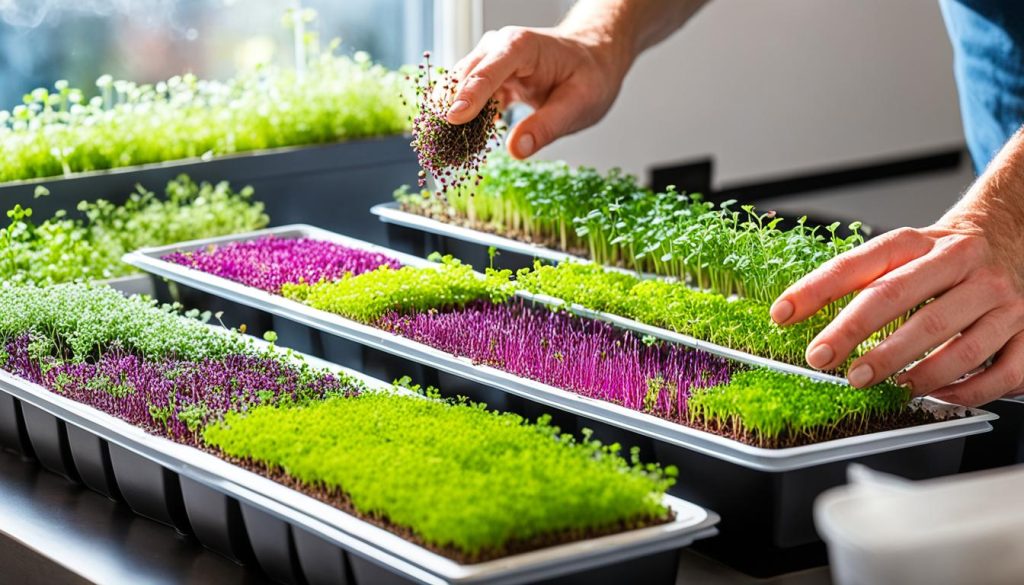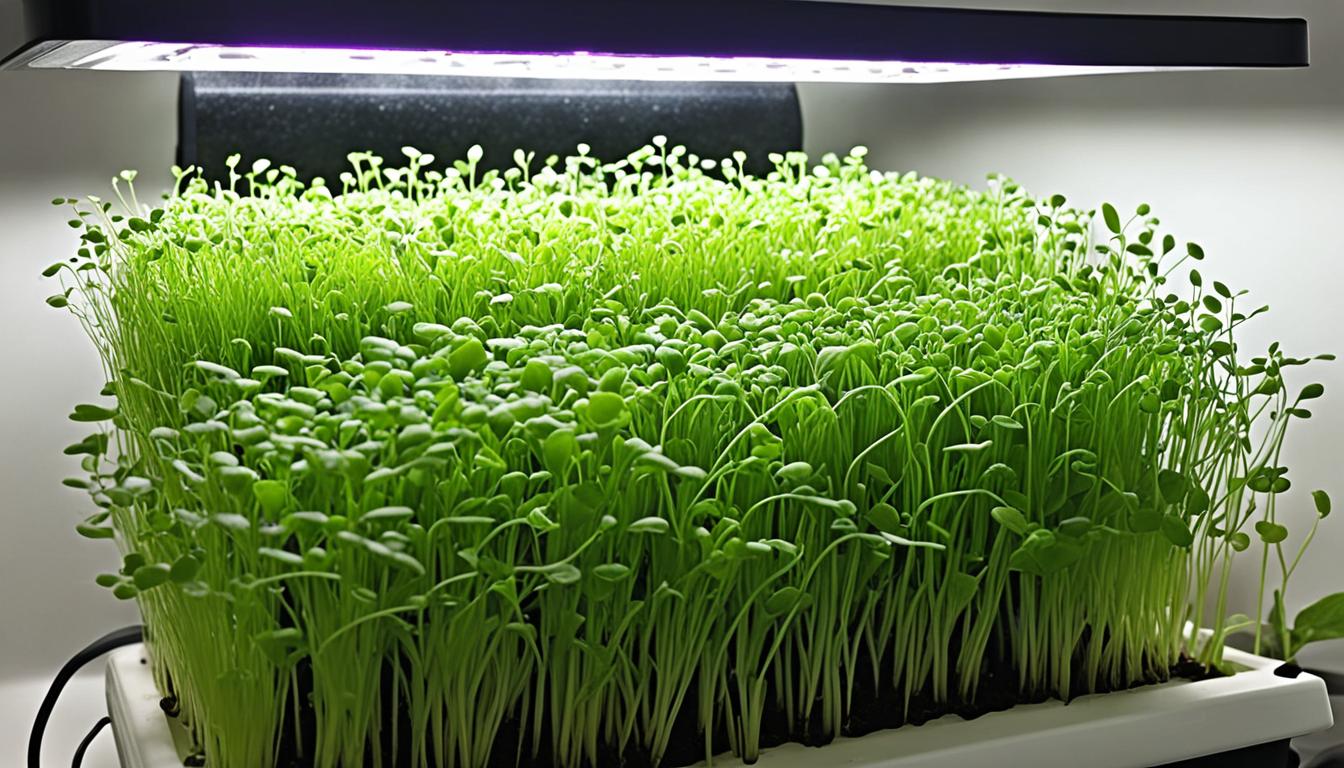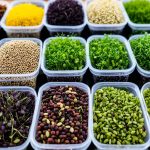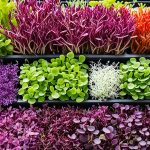Imagine diving into the verdant world of soilless gardening from the comfort of your own home. The lush greenery of microgreens sprouting up without a speck of dirt in sight may seem like a magic trick, but it’s a very real and accessible joy. Today, we’ll explore the revolutionary method of how to grow microgreens without soil, transforming your living space into a miniature farm that’s clean, efficient, and brimming with life.
Succulent, nutritious, and bursting with potential, microgreens are the edible young greens that have taken the culinary and gardening worlds by storm. With these soil-free microgreen growing tips, even those with the tiniest of spaces can yield a harvest that’s both visually striking and remarkably tasty. So, if you’re prepared to dip your toes into the future of urban agriculture, keep reading to embark on a soilless adventure that promises to enlighten your palate and green your thumb!
Introduction to Soil-Free Microgreen Growing
Welcome to the vibrant world of soilless microgreen gardening, an innovative frontier in home agriculture that transcends the bounds of traditional gardening. Imagine cultivating a lush canopy of nutritious greens without a single granule of soil. This modality of indoor microgreen farming is not just a trendy endeavor; it’s a testament to the versatility of hydroponic microgreen cultivation, allowing anyone from urban apartment dwellers to rural homeowners to join the movement towards sustainable and space-saving agriculture.
Adopting soil-free methods might seem daunting at first, but the simplicity and accessibility of growing microgreens in water-based ecosystems is quite astonishing. Whether you’re a novice seeking to sprout your first batch of radish greens, or a seasoned grower keen on optimizing your indoor garden, this approach streamlines the planting process and eliminates the mess associated with traditional soil gardening. Dig into a clean, efficient, and highly rewarding practice that promises a bountiful harvest in the coziness of your own home.
One of the most enticing aspects of this revolutionary gardening practice is that it requires minimal space. You can set up a compact hydroponic system on your kitchen counter, a sunny windowsill, or whatever nook you have available. Moreover, such systems foster rapid growth and healthy, flavorful greens packed with vitamins and minerals. And let’s not forget the sense of fulfillment that comes with harvesting your microgreens mere steps away from where you cook and dine. It’s freshness redefined and a farm-to-table experience within your tactile reach.
As we embark on this journey together, remember that soilless microgreen gardening is not just about what we grow, but how we grow – fostering a deeper connection with our food, embracing advanced agricultural technologies, and reshaping our approach to modern gardening. Get ready to discover the joy and abundance that indoor microgreen farming can offer!
Understanding the Basics of Hydroponic Microgreen Cultivation
As we venture further into the remarkable world of soilless agriculture, it’s essential to grasp the fundamentals of hydroponic techniques for growing microgreens. This innovative approach isn’t just a modern trend; it has deep historical roots and presents a sustainable future for urban farming enthusiasts and commercial producers alike. Here, we’ll unveil how hydroponic systems work and why they are becoming increasingly popular for cultivating nutrient-packed microgreens.
What is Hydroponics?
At its core, hydroponics is a method of growing plants without soil, using nutrient-rich water to deliver sustenance directly to their roots. This technique has transformed how we think about farming, by allowing cultivation in environments previously unsuitable for plant growth. Hydroponics bypasses the unpredictability of soil conditions, offering a controlled habitat for plants to thrive, irrespective of the season.
Benefits of Hydroponic Techniques for Growing Microgreens
When it comes to nurturing microgreens, hydroponics stands out due to its array of compelling advantages. One notable benefit is the accelerated growth rate; in a hydroponic system, microgreens can develop faster because they are provided with an optimal balance of water and nutrients. Moreover, yields tend to increase since plants can be grown more densely and with greater precision. Lastly, the reduced need for pesticides in these controlled conditions results in cleaner, healthier greens. Adopting soil-free microgreen growing tips refined for hydroponic systems ensures that anyone, from home gardeners to commercial farmers, can enjoy these perks.
How to Grow Microgreens Without Soil
Embracing the art of soilless microgreen growing has never been more straightforward, thanks to the innovation of hydroponic microgreen cultivation. This method allows plant enthusiasts and urban gardeners to produce lush, nutritious greens with a minimal footprint—all while bypassing the messiness of soil. If you’re curious about growing microgreens in water, you’re in for an exploration of an efficient and gratifying gardening journey.
Soilless microgreen growing is not only space-efficient but also provides a rapid growth cycle for your edibles. The key steps involve setting up a hydroponic system, selecting suitable microgreen varieties, sowing seeds, and maintaining adequate nutrient levels in the water. The beauty of this approach lies in its simplicity and the joy of watching seeds transform into a vibrant canopy of green within a water-based habitat.
While the full details of each step will be elaborated in upcoming sections, understanding the overarching process is essential. It begins with a reliable hydroponic setup, progresses through the careful monitoring of water quality, and ends with the rewarding task of harvesting your microgreens. Along the way, you’ll discover that the absence of soil brings a clean elegance to gardening that is both refreshing and highly productive.
Whether you’re a seasoned gardener looking to experiment with a new method or a complete novice eager to embark on a gardening adventure, the world of hydroponic microgreen cultivation is inviting you to dive in. Soon, you’ll be on your way to nurturing a lush microgreen garden that thrives on nothing but water, nutrients, and your newfound green thumb.
Choosing the Right Microgreen Varieties for Soilless Cultivation
Embarking on the journey of soilless microgreen growing starts with selecting the ideal varieties that will thrive in a water-based ecosystem. Whether you’re setting up an indoor microgreen farm or experimenting with hydroponic growing on a smaller scale, the success of your green endeavors largely hinges on the types of microgreens you pick. Fast to germinate, easy to maintain, and wonderfully nutritious, soilless microgreens can transform your culinary and gardening experiences.
Best Microgreens for Hydroponic Growing
While most microgreens are adaptable to soilless environments, certain species take particularly well to the hydroponic settings. Leafy greens like kale, arugula, and swiss chard are noted for their robust growth and minimal requirements. Herbs such as basil, cilantro, and dill also exhibit excellent compatibility with hydroponic systems, offering fresh flavors right from your indoor garden. These microgreens not only provide intense flavors and rich nutrients but also have visually appealing growth patterns that can brighten up any space.
Understanding Plant Characteristics
Fundamental to making educated choices for your soilless farm is understanding the unique characteristics of the plant varieties. Characteristics such as root strength and structure, nutrient absorption rates, and growth habits are crucial in a water-centric growing medium. A plant’s ability to anchor itself in a soilless medium and efficiently absorb water and nutrients can dramatically affect its growth and yield. Moreover, knowing the growth patterns of your chosen microgreens can help you prevent overcrowding and ensure optimal exposure to light, thereby maximizing your indoor farming success.
As you delve into the world of soilless microgreen growing, remember that the right plant variety can make all the difference. Whether you’re looking for a peppery kick from arugula or the vibrant colors of radish shoots, your taste preferences and nutritional goals can guide your selection. With a thoughtful start and an understanding of plant characteristics suitable for hydroponic systems, your indoor microgreen farm can flourish, delivering fresh, flavorful greens to your kitchen all year round.
Setting Up Your Indoor Microgreen Farm
Embarking on the journey of indoor microgreen farming starts with creating the perfect environment for your delicate greens to thrive. The first step is selecting a location in your home that receives ample natural light or is well-suited for artificial lighting, as light is paramount for the photosynthesis process. A south-facing window could be ideal, but if that’s not available, a grow light will do just fine.

Once you’ve pinpointed the location, the right equipment will make all the difference. Begin with clean, shallow trays—the foundation of your soil-free setup. Not only do they hold your microgreens, but proper trays also aid in evenly distributing water and nutrients, crucial for uniform growth. Alongside this, investing in a high-quality water mister or a fine spray bottle will be essential for delivering moisture without disturbing the delicate young plants.
An often-overlooked aspect of soil-free microgreen growing tips involves organization and cleanliness. Keeping your growing area tidy is not only aesthetically pleasing but also reduces the risk of pests and diseases, which can quickly decimate your farm. Remember, a clean and well-organized microgreen farm is a productive one.
Planning is key, and with these tips in hand, you are now equipped to set up your very own indoor microgreen farm. Getting started with the right setup will lead to lush, nutritious greens ready for your kitchen in no time. Prepare to embark on a fruitful venture into the world of indoor farming, where fresh produce is just a few snips away.
Exploring Soil-Free Medium Alternatives
Transitioning to a soilless microgreen gardening system invites the opportunity to experiment with a range of mediums that can facilitate healthy plant growth without traditional soil. These alternatives not only offer convenience and cleanliness but also cater to the specific requirements of microgreens for successful cultivation. Let’s delve into the pros and cons of various mediums and how you can set up your growing trays for optimal results. Discovering the right option can significantly enhance your indoor farming experience with enriched yields and robust plant health.
Organic vs. Inorganic Mediums
Understanding the differences between organic and inorganic mediums is crucial for soil-free microgreen growers. Organic mediums, like coconut coir, are derived from natural sources, offering sustainability and often better water retention. Inorganic options such as vermiculite provide excellent aeration, promoting robust root systems. Each type has its advantages, with organic mediums being biodegradable and inorganic ones typically reusable. Your choice will impact not only the growth of your microgreens but also your garden’s environmental footprint.
Preparing Your Growing Trays
Assembling your setup begins with preparing your growing trays — a critical step for successful soil-free microgreen cultivation. Start by selecting a sterile medium, like biostrate felt, to prevent mold and pathogens. Consistency in moisture and making sure your trays are the correct depth for root development is vital. Every choice you make in this setup process can contribute to the taste, texture, and nutritional value of your home-grown greens. Below, you’ll find an image of a microgreen tray prepared with a soil-free medium, ready for planting.
Growing Microgreens in Water: A Step-by-Step Guide
Embracing hydroponic microgreen cultivation is both rewarding and efficient, particularly when growing microgreens in water. This straightforward method eliminates the mess of soil, while affording your microgreens a clean, consistent environment for development. Let’s dive into the stages of soil-free germination and the essentials of water quality for healthy growth.
Germinating Seeds Without Soil
Initiate your journey to luscious greenery by evenly spreading your chosen microgreen seeds across a water-soaked microgreen mat or a similar hydroponic medium. Ensure the medium stays moist but not submerged in water, allowing the seeds optimal hydration for sprouting. A clear cover can aid in maintaining proper moisture levels. It generally takes three to seven days for seeds to germinate, depending on the variety. You’ll know that the germination process is successful once the seeds swell and sprout tiny roots and shoots. If germination is inconsistent or sluggish, considering adjusting your temperature or moisture levels.
Maintaining Water Quality
For peak plant health and vibrancy, prioritize keeping the water used in your hydroponic system pristine. The water’s pH should ideally range from 5.5 to 6.5, fostering the best nutrient uptake for the microgreens. Regularly check and adjust the pH, and make sure to renew the water supply periodically to prevent any build-up of pathogens that could harm your greens. If your microgreens show signs of distress, like discolored leaves or stalled growth, revisit your water quality, as it is a common culprit.
Nutrient Solutions for Soilless Microgreen Growing
When practicing soilless microgreen gardening, the absence of soil means that all the essential nutrients must be supplied through a carefully balanced water solution. These nutrient solutions for soilless microgreen growing are pivotal to plant health and optimal growth. Tailoring the right nutrient mix requires understanding both the plant’s growth cycle and its specific nutrient uptake profile.
To begin selecting an appropriate nutrient mix, consider macro-nutrients like nitrogen, phosphorus, and potassium, which are crucial for microgreen development. Moreover, micro-nutrients such as calcium, magnesium, and iron play a vital role in plant vitality, even in trace amounts. The application of these nutrients should align with the growth stages of the microgreens—too little can lead to deficiency symptoms like yellowing leaves, while too much might cause nutrient burn or stunted growth.
The timing of nutrient application is also a critical factor. Typically, water-soluble fertilizers are added to the water supply either continuously or in intervals, with more frequent replenishment required as the plants mature and their nutrient intake increases. Beginners can start with ready-to-use hydroponic solutions, while seasoned gardeners often prefer custom mixes that address the specific needs of their microgreen varieties.
Understanding and responding to your microgreens’ hunger for certain nutrients will ensure they grow lush and nutrient-rich themselves, becoming a testament to the effectiveness of soilless microgreen gardening. Remember to monitor your plants regularly for signs of nutrient imbalance, and adjust your feeding schedule accordingly to maintain a harmonious growth environment.
Maintaining an Ideal Environment for Soilless Microgreen Gardening
Creating the perfect conditions for soilless microgreen gardening is much like painting a masterpiece. Just as a painter needs the right palette of colors, your indoor microgreen farm requires a harmonious blend of light, temperature, and humidity to nurture the delicate greens to perfection. In this section, we will delve into the essentials of fashioning an environment that’s not just good but great for hydroponic microgreen cultivation.
Lighting Requirements
Light is to microgreens what melodies are to songs—it brings life and vigor. While sunlight is many plants’ preference, the controlled environs of indoor microgreen farming make artificial lighting a practical and efficient choice. High-quality LED grow lights can simulate the full spectrum of sunlight, ensuring your greens get the ‘sunshine’ they crave for photosynthesis even when they’re snug inside your home. The goal is to maintain a ballet of light that dances across your microgreens for 12-16 hours a day, imitating the natural day cycle.
Temperature and Humidity Control
Just as Goldilocks sought porridge that wasn’t too hot or too cold, microgreens thrive in ‘just right’ conditions. Aim for a steady temperature range between 60-70°F (15-21°C) to keep your green babies comfortable. As for humidity, think of it as the nurturing embrace that keeps your microgreens dewy and fresh. A humidity level in the range of 40-60% strikes a balance, preventing water from either abandoning your precious plants or overstaying its welcome and inviting mold. Simple tools like a thermostat and a humidistat can be your trusty allies in managing these elements with precision. With vigilance and care, your hydroponic microgreen cultivation can yield lush, hearty harvests that turn your kitchen into a veritable garden of Eden.
Harvesting Your Soil-Free Microgreens for Optimum Freshness
The journey of mastering how to grow microgreens without soil culminates in the gratifying process of harvesting. Knowing the precise time to clip your greens is paramount to capturing their peak flavor and nutritional value. As such, the magic moment usually occurs just after the first true leaves emerge, which typically signifies that they have reached their nutrient-dense prime. Exercise gentle care as you snip the microgreens just above the root line, and you will find that soilless microgreen growing is not only an accessible endeavor but also an immensely rewarding one.
Once your harvest is ready, proper handling is quintessential in maintaining its freshness. The delicate nature of these tiny greens demands immediate refrigeration if they are not to be consumed straight away. Clean storage containers are your best allies here, ensuring minimal moisture and maximal air flow. This practice effectively extends the vibrancy and shelf life of your greens, making indoor microgreen farming a sustainable loop of continuous cultivation and consumption.
Your experience with soilless microgreen growing should not end with the harvest. Instead, it can mark the beginning of a beautiful cycle of homegrown nutrition and flavor. Embrace the harmony and simplicity of soil-free cultivation, and let your indoor garden be a perpetual source of fresh, home-harvested greens. May your sprouts always be crispy, and your plates forever green!


